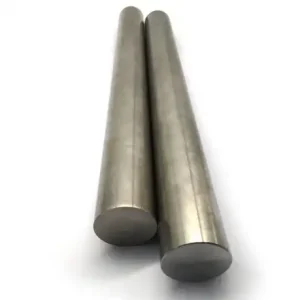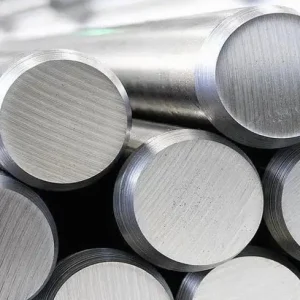12CrMoV (often specified as 12Cr1MoV / 12Cr1MoVG in standards) is a chromium-molybdenum-vanadium low-alloy steel used where elevated-temperature strength and creep resistance are required (boilers, superheaters, main steam lines). For projects that require reliability at metal temperatures up to ~540–580 °C, 12CrMoV-grade seamless pipe is a widely used, cost-efficient choice; choose welded or seamless geometry, post-weld heat treatment (PWHT) and strict quality testing for critical power and petrochemical service. If you need supply, MWalloys offers factory-direct 12CrMoV pipe (Chinese origin) at competitive 100% factory pricing with rapid stock & delivery options for standard dimensions.
What is “12CrMoV”?
The designation “12CrMoV” (commonly appearing as 12Cr1MoV or 12Cr1MoVG) denotes a low-alloy, heat-resisting steel with roughly 1.0–1.2% chromium, around 1% molybdenum and small vanadium additions; carbon is kept low to retain toughness and weldability. It belongs to the family of chrome-moly steels used where elevated-temperature strength and creep resistance matter. In many supplier and standards listings the shorthand is used interchangeably, but always confirm the precise standard (GB/T, EN or ASTM/ASME) referenced on material certificates.
Typical applications & service temperature
Typical uses include: superheater and reheater tubes, main steam lines, headers, boiler piping and similar high-temperature pressure piping in thermal power plants, petrochemical units, and heavy process plants. Long-term service is normally limited to the 540–580 °C region depending on exact composition and section size — designers evaluate creep allowances and choose grade variants or higher-strength CSEF grades (e.g., P91) if operating temperatures approach or exceed that range.
Chemical composition & mechanical properties
Below are commonly accepted composition ranges used by Chinese GB and manufacturing data sheets and cross-checked with supplier MTCs. Always request the manufacturer’s mill test certificate (MTC) and verify the actual analysis.
Chemical composition (typical ranges, wt.%)
| Element | Typical range (wt.%) |
|---|---|
| Carbon (C) | 0.08 – 0.15 |
| Silicon (Si) | 0.17 – 0.37 |
| Manganese (Mn) | 0.40 – 0.70 |
| Phosphorus (P) | ≤ 0.030 |
| Sulfur (S) | ≤ 0.030 |
| Chromium (Cr) | 0.90 – 1.20 |
| Molybdenum (Mo) | 0.25 – 0.60 (common commercial grades ~0.30–0.60) |
| Vanadium (V) | 0.10 – 0.30 |
| Nickel (Ni) | ≤ 0.30 |
| Copper (Cu) | ≤ 0.20 |
| Source: manufacturer datasheets and GB product pages. |
Representative mechanical properties (post-heat treatment)
| Property | Typical value |
|---|---|
| Tensile strength (Rm) | 430 – 600 MPa (varies with heat treatment & exact spec) |
| Yield strength (Rp0.2) | 240 – 380 MPa |
| Elongation (A) | ≥ 12–20% depending on spec |
| Creep resistance | Engineered for long term at ≤ 540–580 °C in boiler service (design dependent) |
| Note: exact numbers depend on normalization & tempering regimes and the standard (GB vs EN vs ASTM). |
Standards, grade names and international equivalents
12CrMoV is specified under various national standards. Common references and equivalences include:
-
GB / GB/T / GB 5310 / GB 9948 — common Chinese boiler / alloy steel tube specifications that list 12Cr1MoV / 12Cr1MoVG grades.
-
EN 10216-2 (seamless steel tubes for pressure purposes) — European technical delivery conditions that cover many heat-resisting steel grades for elevated temperature service.
-
ASME SA/ASTM A335 (seamless ferritic alloy-steel pipe for high-temperature service) — widely used in U.S. and international projects; selection of grade should match design codes and purchaser requirements.
Practical note: Exact grade mapping is project-specific. For procurement, require the exact standard(s) (e.g., GB 5310-2008 12Cr1MoVG or EN 10216-2 Pxxx) on the purchase order and on the MTC.
Metallurgy, heat treatment and PWHT
12CrMoV steels are typically normalized and tempered to develop a tempered martensitic/tempered bainitic microstructure (depending on cooling rate and section) with a matrix that balances strength, toughness and creep resistance.
Key practical points:
-
Normalization temperature typically ~900–950 °C (factory practice varies; check mill tech sheet).
-
Tempering often performed after normalization to achieve required core toughness and reduce hardness.
-
For welded structures, preheat before welding and post-weld heat treatment (PWHT) are often required; preheat temperatures are commonly in the 150–300 °C range and PWHT around 600–700 °C depending on thickness and residual stress control plans. Improper thermal cycles cause microstructural changes that reduce creep life — for critical piping always specify PWHT and an approved welding procedure.
Welding and fabrication guidance
-
Use qualified procedures and welders per project code (ASME, EN or GB). For critical high-temp pipework, follow procedure qualification records (PQRs) and WPQs.
-
Before welding: remove surface scale, ensure recommended preheat (typically 150–300 °C).
-
After welding: perform PWHT to the specified temperature to restore creep resistance and minimize reheat embrittlement risk.
-
Non-destructive tests (NDT) — visual, radiographic (RT) or phased array UT for welds, plus hydrostatic test of completed lengths — are standard acceptance steps. Ask for original test reports and a complete set of MTCs and NDE records.
Corrosion, creep and long-term behavior
12CrMoV offers good oxidation resistance at elevated temperatures (relative to plain carbon steels) because of chromium and molybdenum. However:
Long-term exposure at the upper limit (≥ 540 °C) can lead to microstructural evolution (e.g., carbide coarsening), which reduces creep strength — engineers compensate with safety factors, thicker walls, or higher grades (e.g., P91) where necessary.
Forms, sizes and tolerances
Common product forms: seamless tubes (most common for high-pressure superheater & main steam piping), welded pipes (for non-critical runs), bends, flanges and fittings for boiler/heat-exchanger systems. Diameter ranges and wall thicknesses available from suppliers vary widely; typical seamless boiler tubes range from small OD (≥ 10–20 mm) up to large diameters used for main steam headers. Always specify nominal diameter, schedule/wall thickness, end finish and required third-party tests on the PO.
Quality documentation you must request
Ask suppliers for:
-
Mill Test Certificate (MTC) to EN 10204 3.1 or 3.2 as required.
-
Chemical analysis and mechanical test reports.
-
Heat treatment records and PWHT records.
-
NDT reports (RT/UT), hydro test certificates.
-
Traceability to heat and batch numbers stamped on each pipe.
These items are essential for acceptance by owner/engineers in power, petrochemical and plant projects.
2025 global price comparison
Market note: alloy boiler/seamless pipes trade at a premium to basic carbon pipe — price is extremely sensitive to steel scrap/HRC markets, alloying element premiums (Mo, V), tube dimensions and certification demands. Below are indicative FOB/EXW ranges observed from active supplier listings and market reports in 2024–2025. Use them only as budgeting guidance — request firm quotes for final procurement.
| Region / typical source (2025) | Indicative price range (USD / metric ton, FOB/EXW) | Basis / notes |
|---|---|---|
| China (factory / Alibaba / Made-in-China listings) | $600 – $1,200 / t | Many Chinese suppliers show alloy boiler tube prices in this band depending on MOQ, finish, and certification. |
| India (domestic mills / traders) | $700 – $1,300 / t | Similar alloy premium; higher if specialty heat treatment and export packaging requested. |
| Europe (EU suppliers / EN-certified) | $1,100 – $1,900 / t | Higher due to transport, certification, and stricter testing documentation. EN 10216-2 compliance often carries premium. |
| United States (domestic stock / special orders) | $1,000 – $1,800 / t | Domestic alloy pipe lists and price sheets show elevated prices for ASME-certified items and small-lot buys. |
How to interpret: a quoted price near the lower end is typically for standard stock sizes with basic inspection; the higher end reflects small-lot orders, complete third-party inspection, certified PWHT, and expedited delivery. Always request a full price breakdown (metal cost, processing, tests, packing, freight and duties).
How to select the right variant & procurement checklist
Checklist for engineers & buyers:
-
Confirm design temperature and pressure and check allowable stress tables for candidate grade.
-
Identify the standard required (ASME SA335, EN 10216-2, GB 5310, etc.).
-
Decide seamless vs welded based on service criticality (seamless preferred for high-pressure/st high-temp).
-
Specify heat treatment & PWHT requirements in the PO, and require 3.1/3.2 MTCs.
-
Request weld procedure qualifications, full NDT records and hydrostatic test certificates.
-
If life/corrosion is a major concern, consider higher creep strength alternatives (e.g., P91) or cladding solutions.
-
For procurement: obtain at least 3 firm quotes, check supplier factory audit records and third-party references (especially for safety-critical piping).
MWalloys supply proposition (how we help)
At MWalloys we supply 12CrMoV / 12Cr1MoV seamless and welded pipes with the following buyer advantages:
-
Factory-direct pricing: We operate production partnerships in China and quote 100% factory prices for standard sizes and heat numbers.
-
Fast stock delivery: In-stock common OD/wall sizes for immediate shipment; we prioritize PO release to delivery for emergency orders.
-
Full traceability: Mill heat numbers, MTC to EN 10204 3.1/3.2 (or buyer-required equivalent), welding records and NDT reports included.
-
Tailored documentation: PWHT & hydro test certificates, MTC chemical/mechanical reports and packing for export.
If you want a sample MTC or a firm quotation for a specific diameter / schedule / standard, provide required OD × WT × length, standard (GB/EN/ASME) and target delivery port — we will return a factory quote and lead time.
FAQs
1: Is 12CrMoV the same as P11/P12/P22/P91?
No — P11, P12, P22, P91 (ASME nomenclature) are different chromium/moly grades with different Cr/Mo % and creep strengths. 12Cr1MoV (GB designation) is comparable to some EN/GB low-alloy heat-resistant steels but you must map exact compositions for interchangeability.
2: What is the maximum continuous metal temperature for 12CrMoV?
Practically it is used up to roughly 540–580 °C; long-term creep considerations become critical near that region. Design codes and manufacturer tables must be consulted for allowable stresses.
Q3: Does 12CrMoV need PWHT after welding?
Yes, for most welded assemblies in pressure/steam service PWHT is required to restore toughness and creep resistance. The PWHT regime should be defined in the welding procedure spec.
Q4: Are there direct ASTM or ASME equivalents?
There is not a direct single-line ASTM “12Cr1MoV” number; the correct approach is to identify the target standard (ASME SA335 / EN 10216-2 / GB 5310) and specify grade and acceptance tests accordingly.
5: Is 12CrMoV suitable for corrosive chemical media?
It is primarily a heat-resisting steel, not a corrosion-resistant stainless alloy. For aggressive chemical environments, consider stainless or clad materials. Chromium is present but not at stainless levels.
6: What inspection documents should I insist on?
MTC (EN 10204 3.1/3.2), chemical & mechanical test reports, PWHT report, NDT (RT/UT) weld reports, hydrostatic test certificates, and traceability to heat numbers.
7: Typical lead times?
Stocked sizes can ship in days; custom sizes, special heat treatment and full third-party inspection usually take several weeks. Confirm with supplier and request expedited options if needed.
8: What alternatives if I need higher creep strength?
Creep Strength Enhanced Ferritic (CSEF) steels such as P91/P92 are used at higher metal temperatures or where life-of-plant creep limits are tight.
9: How accurate are online price listings?
Online listings give an indicative band; final price depends on quantity, certification, wall thickness, packaging and shipping. Always ask for a formal PI.
10: What good practice for storage & handling?
Keep pipes stored under cover, off the ground, protect ends from moisture, and keep materials grouped by heat number to maintain traceability for later welding/shop work and inspection. (Standard shop practice.)
Closing recommendations for buyers & engineers
-
Specify the exact standard (GB/EN/ASME), PWHT and inspection level on the PO.
-
Request sample MTC and weld procedure records during RFQ stage — suppliers who supply this promptly are usually quality-oriented.
-
Compare total landed cost, not just raw material price — certified third-party inspection, packing, and transit insurance matter for critical plant projects.
-
If in doubt about temperature margins, consult a creep-life specialist to select a higher-grade alloy.





